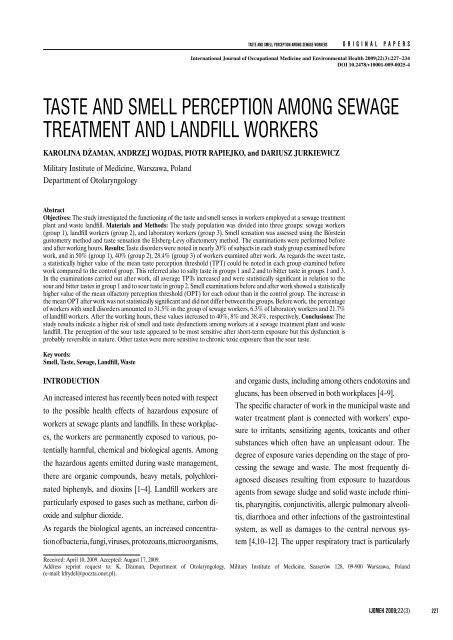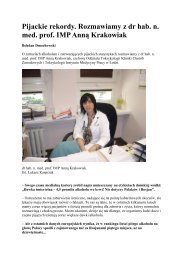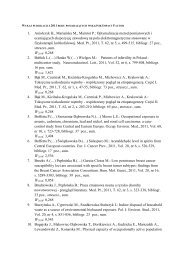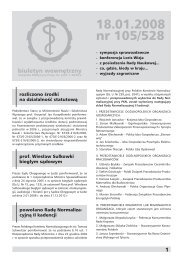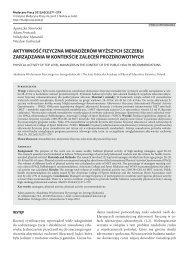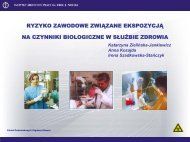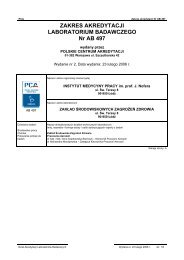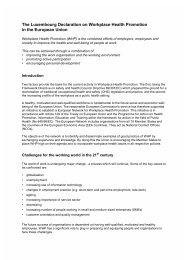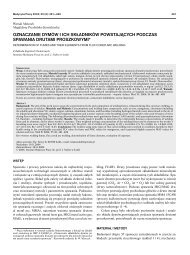taste and smell perception among sewage treatment and landfill ...
taste and smell perception among sewage treatment and landfill ...
taste and smell perception among sewage treatment and landfill ...
Create successful ePaper yourself
Turn your PDF publications into a flip-book with our unique Google optimized e-Paper software.
TASTE AND SMELL PERCEPTION AMONG SEWAGE WORKERSORIGINAL PAPERSInternational Journal of Occupational Medicine <strong>and</strong> Environmental Health 2009;22(3):227 – 234DOI 10.2478/v10001-009-0025-4TASTE AND SMELL PERCEPTION AMONG SEWAGETREATMENT AND LANDFILL WORKERSKAROLINA DŻAMAN, ANDRZEJ WOJDAS, PIOTR RAPIEJKO, <strong>and</strong> DARIUSZ JURKIEWICZMilitary Institute of Medicine, Warszawa, Pol<strong>and</strong>Department of OtolaryngologyAbstractObjectives: The study investigated the functioning of the <strong>taste</strong> <strong>and</strong> <strong>smell</strong> senses in workers employed at a <strong>sewage</strong> <strong>treatment</strong>plant <strong>and</strong> waste l<strong>and</strong>fill. Materials <strong>and</strong> Methods: The study population was divided into three groups: <strong>sewage</strong> workers(group 1), l<strong>and</strong>fill workers (group 2), <strong>and</strong> laboratory workers (group 3). Smell sensation was assessed using the Börsteingustometry method <strong>and</strong> <strong>taste</strong> sensation the Elsberg-Levy olfactometry method. The examinations were performed before<strong>and</strong> after working hours. Results: Taste disorders were noted in nearly 20% of subjects in each study group examined beforework, <strong>and</strong> in 50% (group 1), 40% (group 2), 28.4% (group 3) of workers examined after work. As regards the sweet <strong>taste</strong>,a statistically higher value of the mean <strong>taste</strong> <strong>perception</strong> threshold (TPT) could be noted in each group examined beforework compared to the control group. This referred also to salty <strong>taste</strong> in groups 1 <strong>and</strong> 2 <strong>and</strong> to bitter <strong>taste</strong> in groups 1 <strong>and</strong> 3.In the examinations carried out after work, all average TPTs increased <strong>and</strong> were statistically significant in relation to thesour <strong>and</strong> bitter <strong>taste</strong>s in group 1 <strong>and</strong> to sour <strong>taste</strong> in group 2. Smell examinations before <strong>and</strong> after work showed a statisticallyhigher value of the mean olfactory <strong>perception</strong> threshold (OPT) for each odour than in the control group. The increase inthe mean OPT after work was not statistically significant <strong>and</strong> did not differ between the groups. Before work, the percentageof workers with <strong>smell</strong> disorders amounted to 31.5% in the group of <strong>sewage</strong> workers, 6.3% of laboratory workers <strong>and</strong> 21.7%of l<strong>and</strong>fill workers. After the working hours, these values increased to 40%, 8% <strong>and</strong> 38.4%, respectively. Conclusions: Thestudy results indicate a higher risk of <strong>smell</strong> <strong>and</strong> <strong>taste</strong> dysfunctions <strong>among</strong> workers at a <strong>sewage</strong> <strong>treatment</strong> plant <strong>and</strong> wastel<strong>and</strong>fill. The <strong>perception</strong> of the sour <strong>taste</strong> appeared to be most sensitive after short-term exposure but this dysfunction isprobably reversible in nature. Other <strong>taste</strong>s were more sensitive to chronic toxic exposure than the sour <strong>taste</strong>.Key words:Smell, Taste, Sewage, L<strong>and</strong>fill, WasteINTRODUCTIONAn increased interest has recently been noted with respectto the possible health effects of hazardous exposure ofworkers at <strong>sewage</strong> plants <strong>and</strong> l<strong>and</strong>fills. In these workplaces,the workers are permanently exposed to various, potentiallyharmful, chemical <strong>and</strong> biological agents. Amongthe hazardous agents emitted during waste management,there are organic compounds, heavy metals, polychlorinatedbiphenyls, <strong>and</strong> dioxins [1–4]. L<strong>and</strong>fill workers areparticularly exposed to gases such as methane, carbon dioxide<strong>and</strong> sulphur dioxide.As regards the biological agents, an increased concentrationof bacteria, fungi, viruses, protozoans, microorganisms,<strong>and</strong> organic dusts, including <strong>among</strong> others endotoxins <strong>and</strong>glucans, has been observed in both workplaces [4–9].The specific character of work in the municipal waste <strong>and</strong>water <strong>treatment</strong> plant is connected with workers’ exposureto irritants, sensitizing agents, toxicants <strong>and</strong> othersubstances which often have an unpleasant odour. Thedegree of exposure varies depending on the stage of processingthe <strong>sewage</strong> <strong>and</strong> waste. The most frequently diagnoseddiseases resulting from exposure to hazardousagents from <strong>sewage</strong> sludge <strong>and</strong> solid waste include rhinitis,pharyngitis, conjunctivitis, allergic pulmonary alveolitis,diarrhoea <strong>and</strong> other infections of the gastrointestinalsystem, as well as damages to the central nervous system[4,10–12]. The upper respiratory tract is particularlyReceived: April 10, 2009. Accepted: August 17, 2009.Address reprint request to: K. Dżaman, Department of Otolaryngology, Military Institute of Medicine, Szaserów 128, 09-900 Warszawa, Pol<strong>and</strong>(e-mail: kfrydel@poczta.onet.pl).IJOMEH 2009;22(3) 227
ORIGINAL PAPERSK. DŻAMAN ET AL.exposed to the activity of hazardous agents. The workersat <strong>sewage</strong> <strong>treatment</strong> plants <strong>and</strong> l<strong>and</strong>fills often complainabout malaise, cough, breathing problems as well as ofan unpleasant <strong>taste</strong> in the mouth <strong>and</strong> dysgeusia (<strong>taste</strong>disorder) [4,11,13–14]. Despite the fact that the workershave been complaining about abnormal function of theirsenses, no studies have thus far evaluated the <strong>taste</strong> <strong>and</strong><strong>smell</strong> <strong>perception</strong> in this profession. Therefore, the aim ofthe present project was to assess the functioning of the<strong>taste</strong> <strong>and</strong> <strong>smell</strong> senses <strong>among</strong> <strong>sewage</strong> <strong>treatment</strong> plant <strong>and</strong>l<strong>and</strong>fill workers exposed to biological <strong>and</strong> chemical hazardsin workplace.MATERIALS AND METHODSThe study was conducted <strong>among</strong> 57 workers at the MunicipalService Co. in Chełm, Pol<strong>and</strong>. A combined <strong>sewage</strong><strong>treatment</strong> plant is located there that employs bothmechanical <strong>and</strong> biological <strong>treatment</strong> technologies <strong>and</strong>has a throughput approximating 19 000 m 3 /day. The studypopulation was divided into three subgroups accordingto the kind of exposure: <strong>sewage</strong> workers (23 persons —group 1), l<strong>and</strong>fill workers (19 persons — group 2), laboratoryworkers (15 persons — group 3) (Table 1). The controlgroup comprised 51 healthy volunteers working underno exposure to toxic agents in workplace. The members ofthis group have been working mainly in a hospital <strong>and</strong> hadno contact with agents that could affect the function of the<strong>smell</strong> <strong>and</strong> <strong>taste</strong> senses.The subjects’ age ranged from 25 to 55 years (mean 40.9)<strong>and</strong> the employment duration from 0.5 to 34 years(mean 13.4). About 31% of the subjects reported tobaccosmoking, with the average number of 11 cigarettessmoked daily (5–30 cigarettes/day). The workers includedin the study were only those who had no major anatomicalchanges of nasal <strong>and</strong> oral cavities at a laryngological examination<strong>and</strong> who showed no symptoms of infection on theday of examination. The exclusion criteria were also thediseases that could affect the <strong>taste</strong> <strong>and</strong> <strong>smell</strong> <strong>perception</strong>.Smell was assessed using the Börstein gustometry method,<strong>and</strong> <strong>taste</strong> the Elsberg-Levy olfactometry method [15–17].The examinations were performed before <strong>and</strong> after theworking hours (8 h).The sense of <strong>taste</strong> was evaluated using four substancesrelated to the four basic <strong>taste</strong>s: sweet (glucose:5%, 10%, 20%), bitter (chininum hydrochloride:0.075%, 0.5%, 1%), sour (citric acid: 1%, 5%, 10%)<strong>and</strong> salty (sodium chloride: 2.5%, 7.5%, 15%). The <strong>taste</strong><strong>perception</strong> threshold (TPT) for each <strong>taste</strong> was regardedas the lowest concentration of each solution at whicha given <strong>taste</strong> could be felt. Basing on reference valueswe diagnosed normogeusia (correct <strong>taste</strong> <strong>perception</strong>) ifthe worker felt <strong>taste</strong> at the lowest concentration specified[15,17]. Hypogeusia was diagnosed if the workerTable 1. Characteristics of the study populationParameterWater <strong>treatment</strong> plant(group 1)WorkplaceL<strong>and</strong>fill(group 2)Laboratory(group 3)Number of persons 23 19 15 51ControlsGender (n)Female 0 0 15 25Male 23 19 0 26Age average (years) 41 (25–55) 37 (25–45) 44.9 (26–54) 37.71 (18–62)Average time of work (years) 15.3 (0.5–34) 9.9 (3–16) 15 (0.5–30) 14 (1–29)Smokers (%) 34.8 31.5 26.7 31.4Subjective <strong>taste</strong> dysfunctions (n) 0 0 3.0 0Subjective <strong>smell</strong> dysfunctions (n) 5.0 0 3.0 0n — number of persons.228IJOMEH 2009;22(3)
TASTE AND SMELL PERCEPTION AMONG SEWAGE WORKERSORIGINAL PAPERScould feel <strong>taste</strong> at the other two concentrations <strong>and</strong>ageusia if he did not feel any <strong>taste</strong> at any of the concentrationsstudied.At the assessment of the olfactory sense, air containingeach of the four odours: vanilla, coffee, mint <strong>and</strong> lemon,was insufflated into the nasal cavity. The vanilla <strong>and</strong> coffeeodours activate mainly the olfactory nerve <strong>and</strong> themint <strong>and</strong> lemon odours stimulate both the olfactory <strong>and</strong>trigeminal nerves. The olfactory <strong>perception</strong> threshold(OPT) for each odour was regarded as the volume of insufflatedair at which the worker could feel any odour.Using the reference values we diagnosed normosmia (correct<strong>smell</strong> sense) when the worker could feel odour at insufflating1 to 10 cm 3 of air with vanilla, mint <strong>and</strong> lemonodour <strong>and</strong> 1 to 14 cm 3 of air with coffee odour [17]. If theolfactory <strong>perception</strong> threshold was lower than 40 cm 3 , buthigher than normosmia, we diagnosed hyposmia. In thismethod, anosmia is diagnosed above 40 cm 3 . Before theonset of the examinations, the workers were asked to completea questionnaire for a self-assessment of their <strong>taste</strong><strong>and</strong> <strong>smell</strong> senses.Statistical analysisThe Kolmogorov-Smirnov test was applied to check for thenormal distribution. The normal distribution was adoptedfor the test results K-S d ∈ (0.2–0.4). In the statistical analysis,the Pearson product-moment correlation coefficient<strong>and</strong> Student-t test were used both for the dependent <strong>and</strong>independent variables. Statistical analysis was performedusing STATISTICA-6pl software, with the level of significanceset at α < 0.05.During the gustometric examination, we noted thatsome people did not feel any <strong>taste</strong> at any concentrationof the solution. They were diagnosed with ageusia.In these cases, the <strong>taste</strong> <strong>perception</strong> threshold wasdescribed as 150% of the highest concentration of thesolution (e.g. 30% glucose or 1.5% chininum hydrochloride).During olfactometry, we did not observe anypersons with anosmia.The study was approved by the Bioethical Committee,Military Institute of Medicine, Warszawa, Pol<strong>and</strong>.RESULTSThe gustometric examination performed before work revealed<strong>taste</strong> disorders in 22% of <strong>sewage</strong> workers <strong>and</strong> 17%of laboratory workers <strong>and</strong> l<strong>and</strong>fill workers. In the examinationscarried out after working hours, the percentageof workers with incorrect <strong>taste</strong> <strong>perception</strong> increasedto 50% <strong>among</strong> <strong>sewage</strong> workers, 28.4% laboratory workers<strong>and</strong> 40% l<strong>and</strong>fill workers.The increase in the <strong>perception</strong> threshold of the sweet<strong>taste</strong> was the most frequent finding. In each of the subgroups,the mean TPT for the sweet <strong>taste</strong> differed fromthe results obtained in the control group. The sour <strong>taste</strong>was the only <strong>taste</strong> whose <strong>perception</strong> was correct in thethree subgroups <strong>and</strong> comparable to that recorded forthe control group before work (Fig. 1). Gustometry performedafter 8-hour work shift, showed an increase inthe average TPT for each <strong>taste</strong>, but the changes werestatistically significant only with respect to the sour <strong>and</strong>bitter <strong>taste</strong>s in the group of <strong>sewage</strong> workers <strong>and</strong> to thesour <strong>taste</strong> in l<strong>and</strong>fill workers (Fig. 1). Among the laboratoryworkers, the changes in the mean TPT after workwere not statistically significant for any of the <strong>taste</strong>s.Gustometry performed after work <strong>among</strong> <strong>sewage</strong> workers<strong>and</strong> l<strong>and</strong>fill workers showed abnormal TPT valuesin relation to all the four <strong>taste</strong>s examined. The resultsof assessment of the sweet <strong>and</strong> bitter <strong>taste</strong>s in laboratoryworkers remained similar to those recorded beforework.The olfactory sense examination that had been performedbefore the onset of work revealed an increased OPT ineach group with respect to all the odours (Fig. 2). The resultsdiffered statistically from the findings obtained forthe control group.Coffee <strong>and</strong> lemon OPTs were higher for the <strong>sewage</strong> workers<strong>and</strong> l<strong>and</strong>fill workers than for the laboratory workers(p < 0.05). Before work, the average percentageof workers with <strong>smell</strong> <strong>perception</strong> disorders amountedto 31.5% <strong>among</strong> <strong>sewage</strong> workers, 6.3% laboratory workers<strong>and</strong> 21.7% l<strong>and</strong>fill workers. In the examinations conductedafter work, the average percentage of workers whodid not perceive odours correctly increased to about 40%IJOMEH 2009;22(3) 229
ORIGINAL PAPERSK. DŻAMAN ET AL.Group 1 — Sewage workers, Group 2 — L<strong>and</strong>fill workers, Group 3 — Laboratory workers.The mean TPT is the mean of all TPT measurements for each substance in a given group.Fig. 1. Comparison of mean <strong>taste</strong> <strong>perception</strong> thresholds (TPT) before <strong>and</strong> after work in particular study groups.in the group of <strong>sewage</strong> workers, 8% laboratory workers<strong>and</strong> 38.4% l<strong>and</strong>fill workers.Olfactometry carried out after work shift revealed an increasein the mean OPT for each odour, but this changewas not statistically significant <strong>and</strong> the findings did not differsubstantially between the groups (Fig. 2).DISCUSSIONAn increased interest in occupational diseases resulted inbroad implementation of hygienic st<strong>and</strong>ards <strong>and</strong> safetysolutions to protect the workers against exposure to toxicagents in work environment. Nonetheless, working ata <strong>sewage</strong> <strong>treatment</strong> plant or waste l<strong>and</strong>fill is still connectedwith exposure to a variety of harmful physical, chemical<strong>and</strong> biological agents. Many authors reported on anincreased risk of irritation of the respiratory system, eyes,<strong>and</strong> skin as well as the neurological <strong>and</strong> gastric symptoms<strong>among</strong> <strong>sewage</strong> workers <strong>and</strong> l<strong>and</strong>fill workers [18–19]. Theupper respiratory tract with the olfactory <strong>and</strong> gustatory receptorsis particularly exposed to the activity of hazardousagents. However, available literature lacks reports on theevaluation of the <strong>taste</strong> <strong>and</strong> <strong>smell</strong> senses in this profession.Therefore, the aim of the present study was to assess thefunctions of these senses <strong>among</strong> <strong>sewage</strong> <strong>treatment</strong> <strong>and</strong>waste l<strong>and</strong>fill workers exposed to harmful agents in workplace.The results of gustometric <strong>and</strong> olfactometric examinationsperformed before the onset of work were compared withthose recorded for the control group to estimate the influenceof chronic exposure on the sense organs. Gustometryconducted before work revealed that dysgeusia occurred230IJOMEH 2009;22(3)
TASTE AND SMELL PERCEPTION AMONG SEWAGE WORKERSORIGINAL PAPERSGroup 1 — Sewage workers, Group 2 — L<strong>and</strong>fill workers, Group 3 — Laboratory workers.The mean OPT is the mean of all OPT measurements for each substance in a given group.Fig. 2. Comparison of mean olfactory <strong>perception</strong> thresholds (OPT) before <strong>and</strong> after work in particular study groups.in nearly 20% of workers, irrespective of their job. Abnormal<strong>perception</strong> threshold applied to the sweet, bitter<strong>and</strong> salty <strong>taste</strong>s. It was found that in each group, the sour<strong>taste</strong> was the only one that functioned correctly. Additionally,the olfactometric examination showed a significantlyhigher percentage of <strong>smell</strong> disorders in all the examinedgroups, compared to the control group. Olfactory disorderswere noted mostly <strong>among</strong> <strong>sewage</strong> workers <strong>and</strong> l<strong>and</strong>fillworkers, 30% of whom suffered from hyposmia <strong>and</strong> anosmia.Both the workplaces are associated with exposure toagents that have a damaging effect on the <strong>smell</strong> receptors.The frequency of olfactory disorders <strong>among</strong> <strong>sewage</strong> workerswas comparable to the frequency of nasal cavity irritation(26%) observed by Krajewski et al. [9] in the sameprofession. A higher percentage of <strong>smell</strong> disorders (45%)was noted for workers with long-term exposure to heavymetals [20]. As it could be expected, the laboratory workerswho had little contact with toxic agents, recognized <strong>smell</strong>sbetter than did the <strong>sewage</strong> workers <strong>and</strong> l<strong>and</strong>fill workers,but their results differed from those for the control group.The findings confirmed the suggestions of other authorswith regard to an irreversible dysfunction of the <strong>smell</strong> <strong>and</strong><strong>taste</strong> senses in workers under long-term exposure to harmfulagents in workplace [21].The examinations of the gustatory <strong>and</strong> olfactory thresholdsafter 8-hour workday made it possible to assess thechanges in the sensory <strong>perception</strong> after short-term exposureto hazardous agents. We noted that the <strong>perception</strong> of<strong>taste</strong> deteriorated after work in each workplace, but thechange in TPT was statistically significant only in the <strong>sewage</strong>workers <strong>and</strong> l<strong>and</strong>fill workers. An interesting findingwas the highest increase in TPT for the sour <strong>taste</strong>, whereasIJOMEH 2009;22(3) 231
ORIGINAL PAPERSK. DŻAMAN ET AL.it was the only <strong>taste</strong> that functioned correctly at the firstexamination. Therefore, it appears that the dysfunction ofthe sour <strong>taste</strong> <strong>perception</strong> is reversible <strong>and</strong> that the other<strong>taste</strong>s are more sensitive to the chronic activity of toxicagents. Changes in <strong>taste</strong> <strong>perception</strong> after 8-hour occupationalexposure to toxic chemicals were reported alsoby other researchers [21]. It seems that a reversible, temporarydysfunction of <strong>smell</strong> <strong>and</strong> <strong>taste</strong> may be due to a fatigueof the sensory receptors which is observed even aftershort-term exposure to harmful agents in workplace.Olfactometry performed after work showed an increasedlevel of OPT in each group, but the change was not statisticallysignificant. No differences in olfactometric measurementswere found between particular workplaces.In the analysis, we also considered other factors that couldhave influence on the results. A statistical analysis (testingfor independent variables) was performed to checkthe influence of the differences in the subjects’ age <strong>and</strong>employment duration (Table 2). The total duration of employmentdid not differ statistically between the groups.Table 2. Statistical analysis of between-group differences in thesubjects’ age <strong>and</strong> duration of employmentMeanParameterEmploymentduration (years)Group 1 vs. Group 2 15.167 9.417 1.493 0.148Group 1 vs. Group 3 15.167 14.792 0.083 0.934Group 2 vs. Group 3 9.417 14.792 –1.649 0.113AverageAge (years) t pGroup 1 vs. Group 2 42.800 34.583 2.538 0.018Group 1 vs. Group 3 42.800 44.167 –0.355 0.725Group 2 vs. Group 3 34.583 44.167 –2.863 0.009The statistical analysis revealed age differences betweenparticular subgroups. Thus, we decided to compare the TPT<strong>and</strong> OPT measurements recorded before <strong>and</strong> after work inthese groups with the findings for the control group.Some authors postulated that the functions of both thesenses deteriorated with age, but this was not confirmed inother reports. Some researchers suggest that an increasetpin TPT <strong>and</strong> OPT levels occurs after the age of 60 years,but in our study the oldest worker was 55 years of age (inthe control group there was one worker who was 62 yearsold). Therefore, the age difference did not have any significantimpact on the study results.The number of male <strong>and</strong> female subjects in the studygroups (gender factor) is related to the specific characterof each workplace. The males are more frequently employedin wastewater <strong>treatment</strong> plants <strong>and</strong> l<strong>and</strong>fills whilethe females in laboratories. Therefore, it is very difficultto analyze the impact of the gender factor on the <strong>taste</strong><strong>and</strong> <strong>smell</strong> <strong>perception</strong> in workers at these workplaces. Inthe present study, the TPT <strong>and</strong> OPT measurements werecompared with those for the control group where the proportionof both genders was similar.The analysis of the study results indicate an increased riskof the <strong>smell</strong> <strong>and</strong> <strong>taste</strong> dysfunctions in workers with a longduration of employment in a <strong>sewage</strong> <strong>treatment</strong> plant<strong>and</strong>/or waste l<strong>and</strong>fill. For a detailed interpretation of thefindings for TPT <strong>and</strong> OPT in the context of occupationalexposure it would be necessary to carry out measurementsof the concentrations of air pollutants in each workplace,which could be the subject of further studies.There are literature reports on the studies concerning airconcentrations of harmful biological <strong>and</strong> chemical agents inthe <strong>sewage</strong> <strong>treatment</strong> plant <strong>and</strong> l<strong>and</strong>fill areas [5,18,22–23].Studies investigating the correlation between exposure tohydrogen sulphide <strong>and</strong> endotoxins <strong>and</strong> the illnesses diagnosed<strong>among</strong> <strong>sewage</strong> <strong>and</strong> l<strong>and</strong>fill workers were conductedby Ray [23], Abdou [24] <strong>and</strong> Lee [19]. They noted a statisticallyhigher rate of irritation of the respiratory system, eyes<strong>and</strong> skin as well as the neurological <strong>and</strong> gastric symptoms.This increased rate was found even at exposure to hydrogensulphide below the level of 1 ppm, <strong>and</strong> endotoxins below91 units per m 3 (EU/m 3 ). Smit et al. [18] observed anincreased frequency of health problems under conditionsof endotoxin exposure above the level of 50 U/m 3 .The technological development <strong>and</strong> progress in occupationalmedicine makes it possible to monitor <strong>and</strong> limit occupationalexposure to chemical <strong>and</strong> biological hazards,thus diminishing their influence on workers’ health [25].The quantitative <strong>and</strong> qualitative tests of <strong>smell</strong> <strong>and</strong> <strong>taste</strong>232IJOMEH 2009;22(3)
TASTE AND SMELL PERCEPTION AMONG SEWAGE WORKERSORIGINAL PAPERScould serve as indicators that would help detect the hazards<strong>and</strong> enhance systematic monitoring of the functionsof sense organs. Performing these tests on workers occupationallyexposed to harmful agents provides an opportunityfor assessment of the compensatory ability of boththe sense organs [26].Own experience in investigating the sensory dysfunctionsprompts a complex nature of the causes of dysfunctionsreported in the present study. Presumably, a dysfunctiontakes place at several stages of the reception of thesense stimulus. It is plausible that even the first stagei.e. reaching the receptor by stimulus, can be hinderedby a mechanical barrier, namely oedema of the mucousmembrane irritated by airborne particulates. The processof dissolving chemical stimulus in the mucus layeroften becomes abnormal because of the changes in themucus composition that result from occupational exposure.This leads to a decrease in the connection betweenthe stimulus <strong>and</strong> the receptor. The functions ofthe gustatory <strong>and</strong> olfactory receptors, which are directlyexposed to toxic agents, could also be considered. Thereis a hypothesis that the sensory neuroepithelium is sensitiveto environmental exposure to pollutants [27–29].Finally, the changes can also relate to further parts ofthe sensory tract.The knowledge about the influence of long-term exposureto chemical hazards on the senses of <strong>smell</strong> <strong>and</strong> <strong>taste</strong>is inadequate. Occupational dysfunctions of the <strong>smell</strong> <strong>and</strong><strong>taste</strong> are usually subclinical <strong>and</strong> can often be found onlyduring the olfactometric <strong>and</strong> gustometric examinations.Therefore, the findings presented above show a need fora further research in this area.CONCLUSIONThe gustometry <strong>and</strong> olfactometry results indicate a higherrisk of <strong>smell</strong> <strong>and</strong> <strong>taste</strong> dysfunctions <strong>among</strong> <strong>sewage</strong> <strong>treatment</strong><strong>and</strong> l<strong>and</strong>fill workers. The sense of the sour <strong>taste</strong> appearedto be most sensitive after short-term exposure, butthis dysfunction is probably reversible in nature. The other<strong>taste</strong>s were found to be more sensitive to chronic toxicexposure than the sour <strong>taste</strong>. Occupational dysfunctionof the senses is usually multicausal <strong>and</strong> subclinical in nature.It can often be found exclusively during professionalexaminations.REFERENCES1. Kuszmider G, Mrowiec B, Kubiesa I, Suschka J. The gasiformorganic substances emission to atmosphere from sludge. ArchOchr Środ 1997;23:79–90 [in Polish].2. Lemasters GK, Zenick H, Hertzberg V, Hansen K, Clark S.Fertility of workers chronically exposed to chemically contaminatedsewer wastes. Reprod Toxicol 1991;5:31–7.3. Thornton I, Butler D, Docx P, Hession M, Makropoulos Ch,McMullen M, et al. Pollutants in urban waste water <strong>and</strong> <strong>sewage</strong>sludge. In: European Communities ICON, IC ConsultantsLtd, editors. Final Report. London: Office for OfficialPublications of the European Communities; 2001. p. 1–19.4. Cyprowski M, Krajewski JA. Harmful agents in municipal wastewater<strong>treatment</strong> plants. Med Pr 2003;54(1):73–80 [in Polish].5. Laitinen S, Kangas J, Kotimaa M, Liesivuori J, MartikainenPJ, Nevalainen A, et al. Workers’ exposure to airborne bacteria<strong>and</strong> endotoxins at industrial wastewater <strong>treatment</strong> plants.Am Ind Hyg Assoc J 1994;55(11):1055–60.6. Thorn J, Beijer L, Jonsson T, Ryl<strong>and</strong>er R. Measurement strategiesfor the determination of airborne bacterial endotoxin in<strong>sewage</strong> <strong>treatment</strong> plants. Ann Occup Hyg 2002;46(6):549–54.7. Prażmo Z, Krysińska-Traczyk E, Skórska C, Sitkowska J, CholewaG, Dutkiewicz J. Exposure to bioaerosols in a municipal <strong>sewage</strong><strong>treatment</strong> plant. Ann Agric Environ Med 2003;10:241–8.8. Wlazło A, Pastuszka JS, Łudzeń-Izbińska B. Assessment ofworkers’ exposure to airborne bacteria at a small wastewater<strong>treatment</strong> plant. Med Pr 2002;53:109–14 [in Polish].9. Krajewski JA, Cyprowski M, Szymczak W, Gruchała J.Heath complaints from workplace exposure to bioaerosols:a questionnaire study in <strong>sewage</strong> workers. Ann Agric EnvironMed 2004;11:199–204.10. Scarlett-Kranz JM, Babish JG, Strickl<strong>and</strong> D, Lisk DJ. Health<strong>among</strong> municipal <strong>sewage</strong> <strong>and</strong> water <strong>treatment</strong> workers. ToxicolInd Health 1987;3(3):311–19.11. Thorn J, Kerekes E. Health effects <strong>among</strong> employees in<strong>sewage</strong> <strong>treatment</strong> plants: A literature survey. Am J IndMed 2001;40:170–9.IJOMEH 2009;22(3) 233
ORIGINAL PAPERSK. DŻAMAN ET AL.12. Kraut A, Lilis R, Marcus M, Valciukas JA, Wolff MS, L<strong>and</strong>riganPJ, et al. Neurotoxic effects of solvent exposure on <strong>sewage</strong><strong>treatment</strong> workers. Arch Environ Health 1988;43(4):263–8.13. Ryl<strong>and</strong>er R. Health effects <strong>among</strong> workers in <strong>sewage</strong> <strong>treatment</strong>plants. Occup Environ Med 1999;56(5):354–7.14. Melbostad E, Eduard W, Skogstad A, S<strong>and</strong>ven P, Lassen J,Sřstr<strong>and</strong> P, et al. Exposure to bacterial aerosols <strong>and</strong> work-relatedsymptoms in <strong>sewage</strong> workers. Am J Ind Med 1994;25(1):59–63.15. Taniewski M. Specific gustometry in clinical diagnosis. OtolaryngolPol 1974;28(5):517–22 [in Polish].16. Elsberg ChA, Levy I. Sense of <strong>smell</strong>: new <strong>and</strong> simple methodof quantitative olfactometry. Bull Neurol Inst NewYork 1935;4:1.17. Pruszewicz A. Apropos of gustatory <strong>and</strong> olfactory tests. OtolaryngolPol 1965;19(1):29–37 [in Polish].18. Smit LA, Spaan S, Heederik D. Endotoxin exposure <strong>and</strong>symptoms in wastewater <strong>treatment</strong> workers. Am J IndMed 2005;48(1):30–9.19. Lee JA, Thorne PS, Reynolds SJ, O’Shaughnessy PT.Monitoring risks in association with exposure levels <strong>among</strong>wastewater <strong>treatment</strong> plant workers. J Occup EnvironMed 2007;49(11):1235–48.20. Sułkowski WJ, Rydzewski B, Miarzynska M. Smell impairmentin workers occupationally exposed to cadmium. ActaOtolaryngol 2000;120(2):316–8.21. Borsuk J, Sułkowski W, Miksza J, Najwer K. Smell <strong>and</strong><strong>taste</strong> in workers employed at a c<strong>and</strong>y factory. OtolaryngolPol 1972;26(5):545–51 [in Polish].22. Cyprowski M, Szarapińska-Kwaszewska J, Dudkiewicz B,Krajewski JA, Szadkowska-Stańczyk I. Exposure assessmentto harmful agents in workplaces in <strong>sewage</strong> plant workers. MedPr 2005;56(3):213–22 [in Polish].23. Ray MR, Roychoudhury S, Mukherjee G, Roy S, Lahiri T.Respiratory <strong>and</strong> general health impairments of workers employedin a municipal solid waste disposal at an open l<strong>and</strong>fillsite in Delhi. Int J Hyg Environ Health 2005;208(4):255–62.24. Abdou MH. Health impacts on workers in l<strong>and</strong>fill in JeddahCity, Saudi Arabia. J Egypt Public Health Assoc 2007;82(3–4):319–29.25. Rydzyński K, Pałczyński C. Occupational allergy as a challengeto developing countries. Toxicology 2004;198(1–3):75–82.26. Doty RL. Olfactory dysfunction <strong>and</strong> its measurementin the clinic <strong>and</strong> workplace. Int Arch Occup EnvironHealth 2006;79(4):268–82.27. Gobba F. Olfactory toxicity: long-term effects of occupational exposures.Int Arch Occup Environ Health 2006;79(4):322–31.28. Śliwińska-Kowalska M. Organic solvent exposure <strong>and</strong> hearingloss. Occup Environ Med 2008;65(4):222–3.29. Śliwińska-Kowalska M. Exposure to organic solvent mixture<strong>and</strong> hearing loss: literature overview. Int J Occup Med EnvironHealth 2007;20(4):309–14. DOI 10.2478/v10001-007-0032-2.234IJOMEH 2009;22(3)


